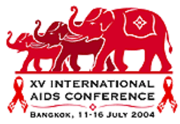 |
 |
 |
| |
Extensive Resistance Testing During 5 Years of Lopinavir/ritonavir Treatment in Antiretroviral-Naive HIV-infected Patients: Results from Study 720
|
| |
| |
|
|
| |
| |
 |
|
| |
| |
XV International AIDS Conference, Bangkok, Thailand, 11--16 July 2004
Abstract WeOrB1291
C Hicks1, B da Silva2, M King2, C Benson3, P Wolfe4, R Gulick5, M Glesby5, AC White6, R Murphy7, H Kessler8, M Albrecht9, M Thompson10, J Eron11, KR King2, F McMillan2, S Brun2
1Duke University Medical Center, NC; 2Abbott Laboratories, IL; 3University of Colorado Health Sciences Center, CO; 4Pacific Oaks Research, CA;
5Weill Medical College of Cornell University, NY; 6Thomas Street Clinic/Baylor College of Medicine,TX; 7Northwestern University, IL;
8Rush Medical College, IL; 9Harvard University, MA; 10AIDS Research Consortium of Atlanta,GA; 11University of North Carolina at Chapel Hill, NC
The study authors concluded:
Based on extensive resistance testing among 100 ARV-naive patients with up to 5+ years of treatment with LPV/r + d4T/3TC:
--No LPV resistance detected
--No d4T resistance (TAMs) detected
--3TC resistance observed in 3 patients
New secondary mutations/polymorphisms in protease in 6 patients were not associated with LPV resistance:
--LPV phenotypic susceptibility remained
--HIV RNA was <400 c/mL in 4/4 with subsequent values
--In ARV-naive patients treated with a LPV/r-based regimen for a median of >5 years, risk of PI and NRTI resistance was low.
BACKGROUND
Several studies of lopinavir/ritonavir-based regimens and 1 study of ritonavir-boosted fosamprenavir in ARV-naive patients have shown an absence of protease mutations at viral rebound. Long-term evaluation of this phenomenon is needed. Whether other ritonavir-boosted regimens will demonstrate similar results is unknown.
RTV Boosted PI Regimens Demonstrating No Evidence of PI Resistance in ART-Naïve Patients
| Study | PI Regimen | N | Duration | Prim PI-Resist | | 863 | LPV/r bid | 326 | 96 wks | 0/51 | | 940 | LPV/r bid | 44 | 72 | 0/13 | | 056 | LPV/r qd/bid | 38 | 72 | 0/5 | | 418 | LPV/r qd/bid | 190 | 48 | 0/15 | | SOLO | APV/r qd | 322 | 48 | 0/32 |
METHODS
In Study 720 100 antiretroviral-naive patients with median baseline HIV RNA and CD4 count of 4.8 log10 copies/mL and 326 cells/mm3, respectively, received lopinavir/ritonavir, stavudine, and lamivudine.
Any patient with HIV RNA >500 copies/mL any time at or after Week 24 had at least 1 sample submitted for testing:
--Genotypic and phenotypic resistance testing (GeneSeq, PhenoSense, ViroLogic) was conducted for each rebound sample
--Corresponding baseline isolates were also analyzed
Primary resistance definitions:
--LPV: Any primary/active site mutation in protease (amino acids 8, 30, 32, 46, 47, 48, 50, 54, 82, 84, 90)
--3TC: M184V/I/T mutation in reverse transcriptase (RT)
--d4T: Thymidine analog mutation in RT (amino acids 41, 67, 70, 210, 215, 219)
The emergence of secondary mutations/polymorphisms in protease was also assessed.
RESULTS
Disposition and Antiviral Activity
As presented previously, 68 patients remained on study for at least 5 years
By intent-to-treat analysis, 67/100 and 64/100 patients had HIV RNA <400 or <50 copies/mL at Week 252.
DISCONTINUATIONS THRU WEEK 252
Prior to wk 252: 32; adverse events: 13; lost to followup: 9; nonadherence: 5; personal/other; total=68
PRIMARY RESISTANCE
27 patients were eligible for resistance testing, with a total of 32 samples submitted.
16 patients met criteria for loss of virologic response, and 11 patients had at least 1 "blip" (single HIV RNA value >500 copies/mL bracketed by HIV RNA values <400 copies/mL) after Week 24.
Testing failed in 10 samples due to low HIV RNA levels (median 575, IQR 513-828 copies/mL).
In 17 patients with available results, no lopinavir or stavudine resistance was observed, and 3 patients demonstrated lamivudine resistance.
Absence of resistance was confirmed by phenotypic testing.
Mean HIV RNA levels were similar in patients with vs. without 3TC resistance.
Secondary Protease Mutations/Polymorphisms
6 patients demonstrated a substitution at a new protease position at viral rebound (I15I/V, M36M/I, K43K/R, R57R/K, L63L/P, K70R).
Rebound phenotypic lopinavir susceptibility (mean=0.7 fold wild type) was no different vs. patients with no changes from baseline (mean=0.8 fold wild type, p=0.6).
|
| |
|
 |
 |
|
|